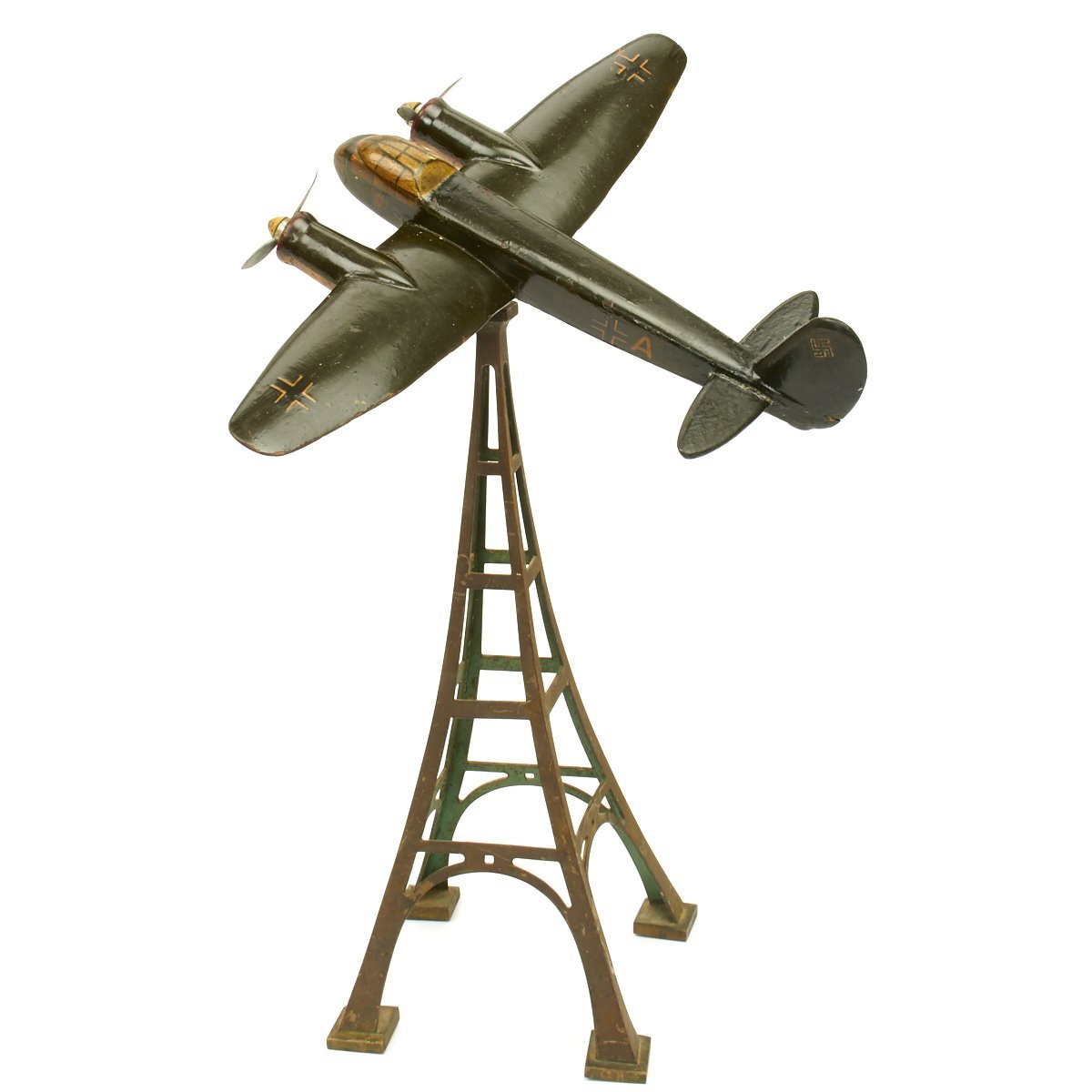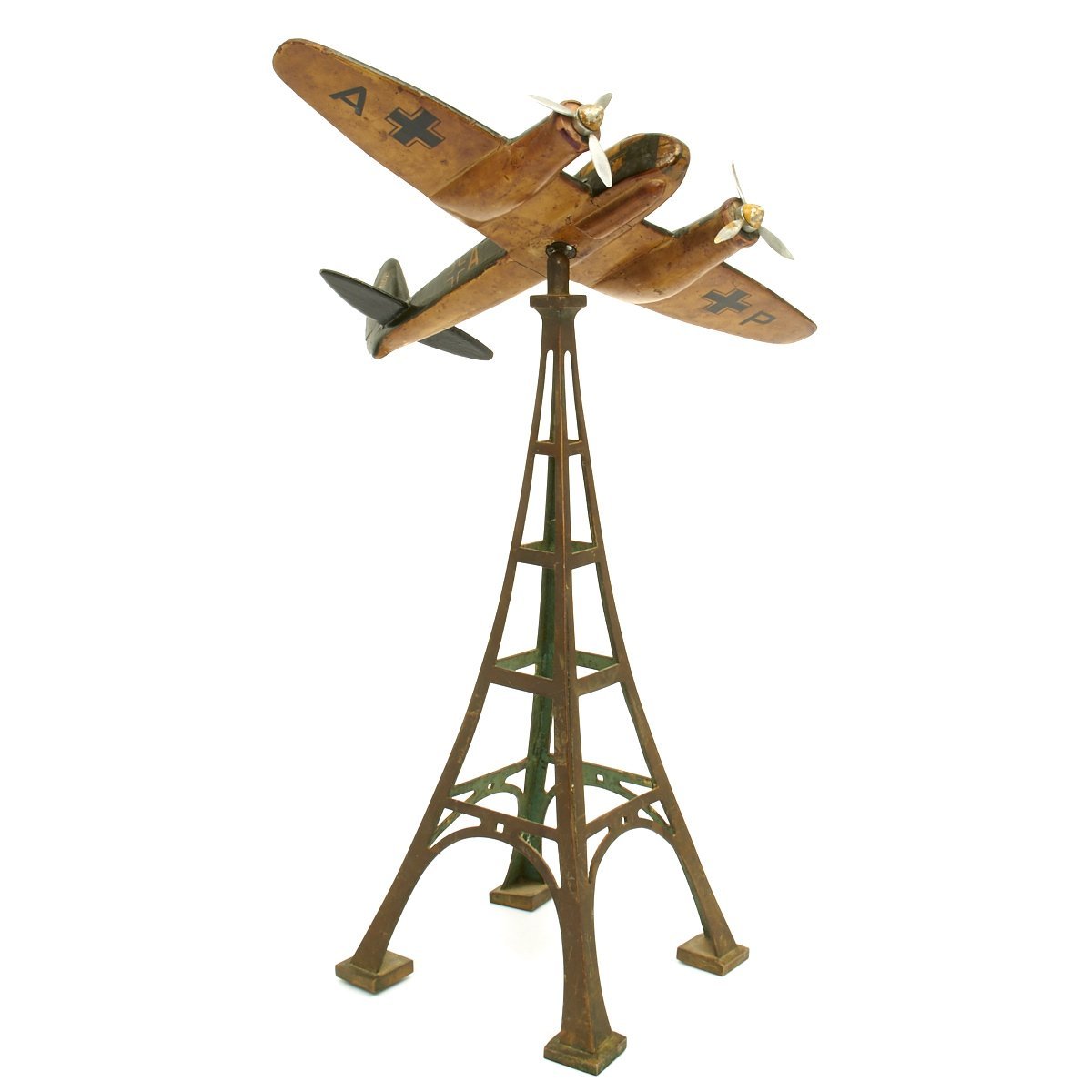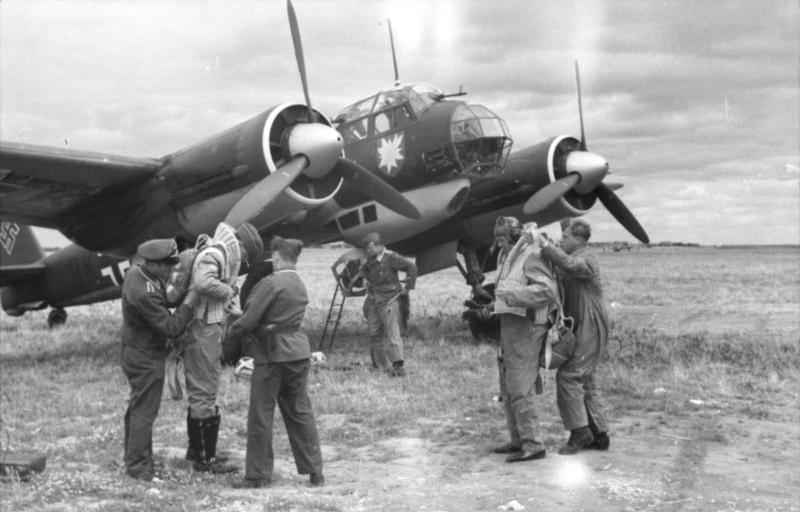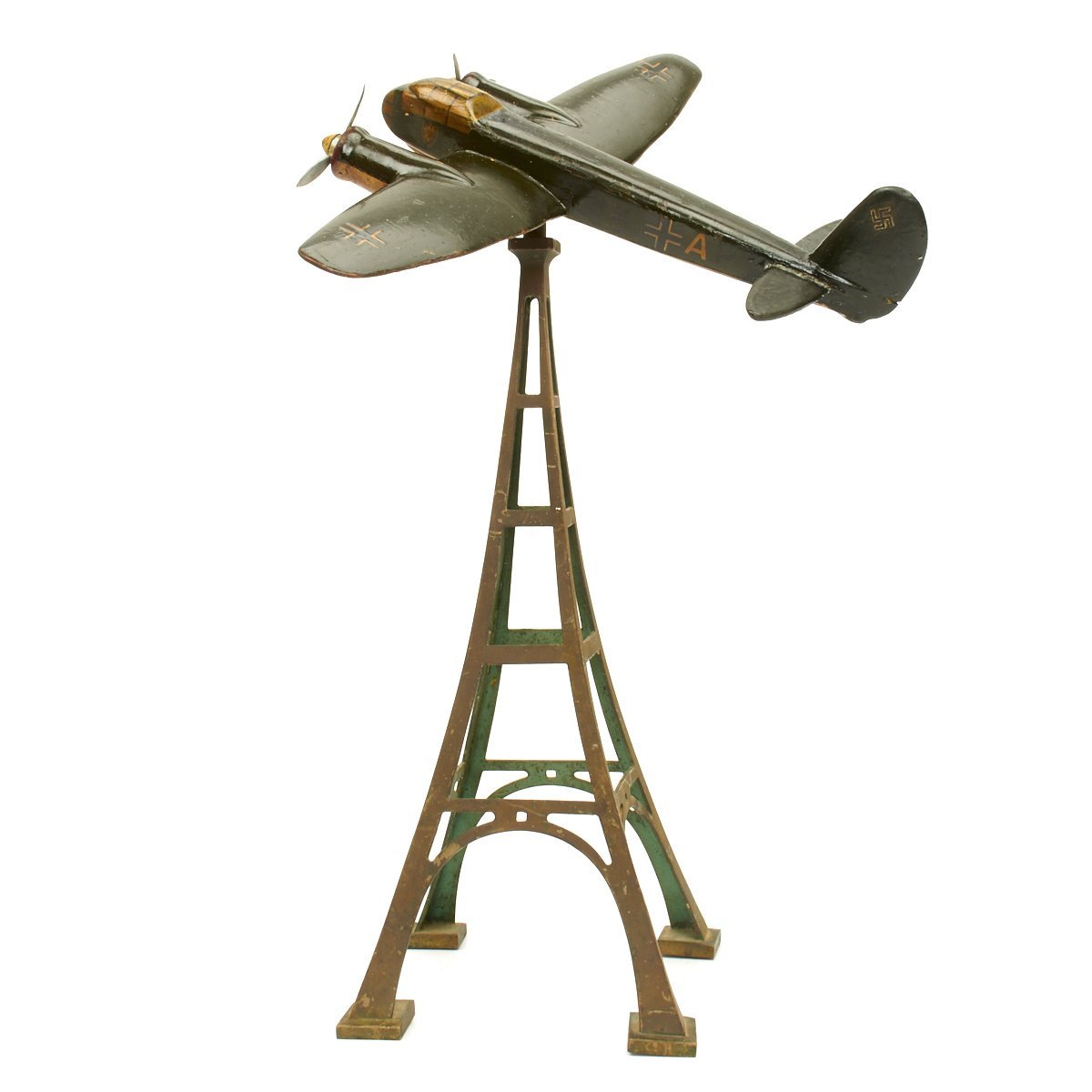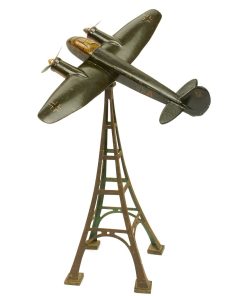Original German WWII Luftwaffe Edelweiss 51 Junkers Ju 88 Bomber Over Eiffel Tower Model Original Items
$ 1.395,00 $ 348,75
Original Items: One-of-a-kind. This is an incredible wartime handmade model of a Junkers Ju 88 German aircraft in flight over the Eiffel tower. The entire model measures 20″ tall, the wingspan of the plane is 15″ and the base of the Eiffel Tower is 6.5″ square.
The Junkers Ju 88 aircraft is wonderfully carved wood and hand painted. It features spinning metal propellers, German Balkenkreuz crosses on each wing, above and below, lettering along the body of the plane that reads 9K+AP and swass on the tail. On each side of the cock pit is an Edelweiss flower inside a shield. The Edelweiss represents Kampfgeschwader 51. “Edelweiss” KG 51 (Battle Wing 51) was a Luftwaffe bomber wing during World War II. The unit began forming in December 1939. The unit operated the Dornier Do 17, Heinkel He 111 and Junkers Ju 88 light and medium bombers.
The Eiffel Tower is constructed of brass and has a wonderful green tone to the interior. The Tower stands 18 inches tall and on the top is a clever screw assembly that allows the plane to screw into it an an angle making the plane appear as if it ascending on a bank turn over the tower itself.
Who made it and where did it sit? One can just imagine this on a Luftwaffe officer’s desk in celebration of the occupation of Paris in June, 1940.
“Edelweiss” KG 51 – Stab/KG 51 and I./KG 51 were formed on 1 May 1939 at Landsberg am Lech, and the formation was completed on 20 August 1939. The units were initially designated KG 255. The units were initially equipped with the Do 17Ps, but later reequipped with He 111Hs in August 1939. The unit spent most of the summer training and recruiting personnel from the flight schools, and the Geschwader did not see much action during the invasion of Poland.
Operational history
France and the Low Countries
At the start of the Battle of France the Strength of Stab./KG 51 with nine He 111s, all were serviceable. However this was soon reduced to a Stabskette. On the day of the western offensive the unit had just a single He 111 and Ju 88. The strength of I./K 51 on the 10 May 1940 stood at 36 He 111s of which 34 were serviceable. II./KG had 38 Ju 88s on hand, of which just 15 were serviceable.[3] The third Gruppen, III.KG 51, was equipped with 39 He 111s, of which 29 were air worthy on 10 May.
I./KG 51 was heavily engaged and supporting the breakthrough at Sedan. It reported losses on 18, 24 of May and 9 June. The group’s first Ju 88 loss occurred on 5 June. After the French surrender, the unit relocated to Paris. II.KG 51 supported German forces during the Battle of Dunkirk and flew missions along the Franco-Swiss border. It relocated to Étampes-Mondésir, south west of Paris on 20 June 1940. III./KG 51 also engaged in combat during the campaign. Elements of this unit accidentally bombed Freiburg, killing 57 people and injuring 101, including 22 children. The pilot, Leutnant Paul Seidel was distraught over the error, until he was shot down and killed over Portsmouth on 12 August 1940. This Gruppe contained some Ju 88s, but all operations were flown with the He 111H.
Battle of Britain
KG 51 was heavily involved in the Battle of Britain. I./KG 51 recorded its first (a Ju 88) loss on the battle on 1 July 1940, near Dunbar, Scotland. I./KG bombed British shipping in the English Channel throughout July. The unit attacked Royal Navy destroyers of St. Catherine’s head on 12 July and bombed Bristol on 17th. Another loss was reported near Land’s End on 27 July. The attrition rate steadily grew. On 13 August 1940, the unit had 30 Ju 88s, of which 21 were operational. By 19 August it had 33 Ju 88s in service, but could only muster 13 for operations. The unit continued to bomb Britain until March 1941. During the first four months, (1 July – 31 October 1940), the Gruppe lost 13 Ju 88s and 21 damaged. During the Blitz the unit bombed Portsmouth, London, Coventry, Manchester and Liverpool. On 31 March 1941 the Gruppe withdrew to Austria for a refit. II./KG also suffered considerable losses. On 13 August 1940 the Gruppe had 34 machines of which 24 were serviceable. By 7 September, while the total strength remained 34 Ju 88s, just 17 were combat-ready. The Gruppe recorded 13 complete losses and 12 damaged between 1 July and 31 October 1940. It later participated in the same attacks as I./KG 51.[6] III./KG 51 was assigned the same tasks as its sister units. On 13 August it had 32 Ju 88s and 25 serviceable. By 7 September, that number had grown to 27 out of 34 combat-ready. Attacks over Britain between 1 July and 31 October cost it 12 aircraft destroyed with 19 damaged. On 5 April 1941 in relocated to Wiener Neustadt in Austria. It was placed under Luftflotte 4 for the coming Balkans Campaign. During the campaign IV.(Erg)/KG 51 was formed in either later July or early August. Located at Lechfeld, the Gruppe was expanded into a IV. Gruppe on 22 March 1941.
Balkans Campaign
Stab./KG 51 saw action during the Balkans Campaign. The took part in the Bombing of Belgrade and attacked retreating Allied forces through Greece. It handed over its remaining aircraft to Lehrgeschwader 1.[5] I./KG 51 also took part, bombing Belgrade and Athens (on 15 April). It had a strength of 29 Ju 88s and 17 serviceable. It took part in missions against Allied shipping, in and around Crete. It handed over its aircraft to I./LG 1 on 13 May and went to Austria to refit.[9] II./KG 51 had a total of 28 and 18 serviceable Ju 88s on hand. It reported a single loss over vic Banja Luka on 12 April. The unit relocated to Poland on 20 June 1941.
Eastern Front
The Geschwader lost 15 aircraft, and its strength was down to one-third by 30 June. In September 1941 it flew 810 sorties in southern Russia and was credited with 27 aircraft shot down, 290 vehicles, 22 tanks, one train and 5 Soviet ships. In return it lost just two aircraft. Between 1–30 November 1941 the unit relocated to Nikolayev, Ukraine. In a month it flew 412 sorties, and was credited with a further 10 aircraft, 8 trains, 315 vehicles, one heavy cruiser (the Voroshilov on 2 November, the ship was heavily damaged and put out of action for several months) and 2 freighters destroyed for the loss of three aircraft. In February 1942 the Geschwader destroyed one train, some 100 vehicles in 335 sorties for three losses.
The Geschwader continued to fight on the Eastern Front throughout 1942-44. It supported the Heer during the Siege of Sevastopol, Second Battle of Kharkov, Battle of Stalingrad and the Battle of Kursk. During the siege of the German Sixth Army at Stalingrad, on 30 January 1943, the Kampfgeschwader 51 destroyed the Soviet 51st Army’s Headquarters, near Salsk. Dropping 100 – 250 kg bombs, a wave of Junkers Ju 88s and Heinkel He 111s destroyed the communications centre, working offices of the chief-of-staff, the operational headquarters and the offices of the operational duty officer. Up to 20 buildings and personnel billets were also destroyed. Casualties among personnel were also very high.
On 31 December 1943 the Gruppe, after being initially being ordered to convert to Me 410s, was disbanded. III./KG 51 was reformed on 20 October 1944. Only to be reformed, as I.SKG 10, equipped with Fw 190s, a month later.[13] II./KG 51 was also disbanded, in January 1944, but was reformed in February 1944. The unit was also equipped with Me 262s, and saw action as a bomber intercept and fighter-bomber unit until it was disbanded on 24 April 1945, and its personnel sent to infantry units.
“Defense of the Reich” and Western Front
The unit took part in the latter part of the Western Front campaign and the “Defense of the Reich” battles. On 8 May 1943, I./KG 51 was sent to Germany for conversion to the Messerschmitt Me 410. By 25 December 1943, the unit had 36 crews, with 40 (24 serviceable) Me 410s. During this time it also participated in bombing raids against England until 23 May 1944. The Gruppe was decimated in the raids.[15] Elements of the Geschwader converted to the Messerschmitt Me 262 and flew fight-bomber and bomber intercept missions against Allied bomber streams from June 1944 to May 1945. I./KG 51 participated in attacks on Allied airfields to support German forces during the Battle of the Bulge. The Gruppe did not have more than 38 Me 262s at any one time.
Fast Shipping with Professional Packaging
Thanks to our longstanding association with UPS FedEx DHL, and other major international carriers, we are able to provide a range of shipping options. Our warehouse staff is expertly trained and will wrap your products according to our exact and precise specifications. Prior to shipping, your goods will be thoroughly examined and securely secured. We ship to thousands clients each day across multiple countries. This shows how we're dedicated to be the largest retailer on the internet. Warehouses and distribution centres can be located throughout Europe as well as the USA.
Note: Orders with more than one item will be assigned a processing date depending on the item.
Before shipping before shipping, we'll conduct a thorough inspection of the items you have ordered. Today, the majority of orders will be delivered within 48 hours. The delivery time will be between 3-7 days.
Returns
The stock is dynamic and we cannot completely manage it because multiple stakeholders are involved, including our factory and warehouse. So the actual stock may alter at any time. It's possible that you may not receive your order once the order has been made.
Our policy is valid for a period of 30 days. If you don't receive the product within 30 days, we are not able to issue a refund or an exchange.
You can only return an item if it is unused and in the same state as the day you received it. You must have the item in its original packaging.
Related products
Uncategorized
Uncategorized
Uncategorized
Australian WWII Owen MK1 Machine Carbine SMG Custom Fabricated Replica with Sling Original Items
Uncategorized
Uncategorized
Uncategorized
Armoured Fighting Vehicles of the World: AFVs of World War One (Hardcover Book) New Made Items
Uncategorized
Uncategorized
Uncategorized
Band of Brothers ORIGINAL GERMAN WWII Le. F.H. 18 10.5cm ARTILLERY PIECE Original Items
Uncategorized
Uncategorized
Uncategorized
Armored Burgonet Helmet & Polearm from Scottish Castle Leith Hall Circa 1700 Original Items
Uncategorized
Uncategorized
Uncategorized
Uncategorized
Uncategorized
Uncategorized
Uncategorized
